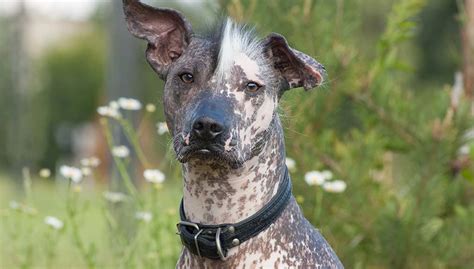Discover the unique physical characteristics and extraordinary temperament of this uncommon breed, along with their special care and grooming needs. Learn about their rare health conditions and preferred exercise and activity.
Unique Physical Characteristics
Exotic dog breeds are known for their unique physical characteristics that set them apart from more common breeds. From the unusual shapes of their bodies to the distinctive patterns of their coats, these dogs are truly one-of-a-kind. Take the Dachshund, for example, with its long, low-slung body and short legs. This breed’s elongated physique is a standout feature that makes them easily recognizable. On the other hand, the Chinese Crested is known for its lack of hair, except for on its head, tail, and paws, giving it a highly unique and eye-catching appearance.
Another example of a breed with unique physical characteristics is the Basenji, known for its curled tail and wrinkled forehead. These quirky physical traits make the Basenji stand out in a crowd of more conventionally-shaped dogs. Then there’s the Shar Pei, whose loose, wrinkled skin gives it a distinctive appearance unlike any other breed. These unique physical characteristics are what draw many people to exotic dog breeds, as they offer a refreshing change from the more common and typical appearances of traditional breeds.
When considering adopting an exotic dog breed with unique physical characteristics, it’s important to appreciate and understand the extra care and attention that may be required for their maintenance. Their distinctive features often come with specific grooming, exercise, and health needs that differ from those of more standard breeds. However, for many dog enthusiasts, the chance to own a pet with unique physical characteristics is a rewarding and fulfilling experience, as these dogs truly stand out from the pack in more ways than one.
Extraordinary Temperament and Personality
When it comes to exotic dog breeds, there are many factors that set them apart from more common breeds. One of these factors is their extraordinary temperament and personality. Exotic breeds are known for their unique characteristics and behaviors that make them stand out in the dog world.
These exotic breeds often have a strong sense of loyalty and a fierce independence that sets them apart from other breeds. They have a natural intelligence and curiosity, along with a playful and energetic nature that makes them a joy to be around. Their temperament and personality can vary widely from breed to breed, but they all share a certain level of uniqueness that makes them so special.
Whether you’re considering adding an exotic breed to your family or simply interested in learning more about these fascinating dogs, their extraordinary temperament and personality is sure to leave a lasting impression.
Uncommon Breeding History
When it comes to exotic dog breeds, their breeding history is often more complex and fascinating than that of more common breeds. Many exotic dog breeds have a unique lineage that sets them apart from other dogs. Some of these breeds have been developed and refined over centuries by isolated communities or cultures, resulting in a diverse genetic background that contributes to their distinct physical and behavioral traits.
Additionally, some exotic dog breeds have a limited population due to selective breeding or geographic isolation, making them rare and unique in the world of dogs. Their breeding history may include cross-breeding between uncommon or ancient breeds, resulting in unusual combinations of characteristics that are not seen in other dogs.
Understanding the breeding history of exotic dog breeds can provide insight into their distinct traits and behaviors, and may also shed light on heritable health concerns that potential owners should be aware of. It’s important for prospective owners of exotic dog breeds to educate themselves about their breeding history in order to provide the care and attention these special dogs need.
Special Care and Training Needs
When it comes to owning an exotic dog breed, it’s important to understand that they may have special care and training needs that are different from more common breeds. These unique breeds often require extra attention and specific training techniques to ensure they are well-behaved and healthy.
Owners of exotic dog breeds should be prepared to invest the time and effort into providing the special care that these breeds require. This may include regular grooming, specialized diets, and additional vet care to address any potential health concerns that are unique to these breeds.
Additionally, training an exotic dog breed may require a different approach than training a more traditional breed. It’s essential to do thorough research and seek guidance from experienced trainers to ensure that the training methods used are suitable for the specific needs of the exotic breed.
Rare Health Conditions and Concerns
Exotic Dog Breeds That Stand Out from the Pack
When it comes to exotic dog breeds, it’s important to be aware of the unique health conditions and concerns that may be associated with these extraordinary animals. Unlike more common breeds, exotic dogs may have a higher risk of certain rare health issues that require additional attention and care from their owners.
One rare health condition that exotic dog breeds may be prone to is brachycephalic syndrome, which can affect breeds with short, flat faces such as the Pug or Bulldog. This condition can lead to breathing difficulties, especially in hot or humid weather, and may require special accommodations and veterinary care to manage effectively.
Another concern for exotic dog breeds is the potential for genetic predispositions to certain health conditions. Because many exotic breeds have a limited gene pool, they may be more susceptible to inherited diseases such as hip dysplasia or heart conditions. It’s important for owners of exotic dogs to work closely with their veterinarians to monitor and address any potential genetic health risks.
Distinctive Grooming and Maintenance Requirements
When it comes to exotic dog breeds, their distinctive characteristics often extend to their unique grooming and maintenance needs. One such breed is the Afghan Hound, known for its long, flowing coat that requires regular brushing and grooming to prevent matting and tangles. This breed also tends to have sensitive skin, so gentle grooming products and regular bathing are essential to keep their coat in top condition.
Another exotic breed with distinctive grooming requirements is the Chinese Crested. This breed comes in two varieties: the hairless and the powderpuff. While the hairless variety requires regular skincare to protect their exposed skin from sun and environmental elements, the powderpuff variety needs frequent brushing and grooming to maintain their long, flowing coat. Understanding the specific needs of each variety is crucial for proper grooming and maintenance of Chinese Crested dogs.
Additionally, the Tibetan Terrier is another exotic breed with unique grooming needs. Despite their name, these dogs are not true terriers and possess a thick, double coat that requires regular brushing and combing to prevent matting. Their coat also grows continuously, similar to human hair, so professional grooming and trimming may be necessary to keep their coat at a manageable length.
Extraordinary Exercise and Activity Preferences
Dogs come in all shapes and sizes, and some exotic breeds have extraordinary exercise and activity preferences that set them apart from the rest. These unique breeds require specific types of physical activity to keep them happy and healthy. From running and swimming to agility training and mental stimulation, these dogs thrive on active lifestyles.
One such exotic breed with extraordinary exercise and activity preferences is the Australian Shepherd. Known for their high energy levels and agility, Australian Shepherds excel in activities such as flyball, herding, and obedience training. These intelligent and energetic dogs require regular exercise and mental stimulation to prevent boredom and destructive behavior.
Another exotic breed with extraordinary exercise and activity preferences is the Siberian Husky. Originating from Siberia, these dogs have a natural predisposition for running and pulling sleds. Huskies thrive in cold climates and enjoy activities such as skijoring, bikejoring, and canicross. Without enough physical activity, Huskies can become restless and exhibit destructive behaviors.
Frequently Asked Questions
What are some exotic dog breeds?
Some exotic dog breeds include the Thai Ridgeback, Xoloitzcuintli, Azawakh, and the Bergamasco.
What makes these dog breeds stand out?
These dog breeds stand out due to their unique physical features, history, and origin from specific regions around the world.
Are exotic dog breeds suitable as pets?
Exotic dog breeds can make great pets for the right owner who is willing to meet their specific needs and provide proper care and training.
What are some challenges of owning an exotic dog breed?
Challenges may include finding a reputable breeder, potential health issues specific to the breed, and understanding their cultural and historical background.
How can someone find an exotic dog breed to adopt?
Research reputable breeders, attend dog shows and events focused on rare breeds, and consider adoption from rescue organizations specializing in exotic breeds.
What are some misconceptions about exotic dog breeds?
One common misconception is that exotic dog breeds are inherently aggressive or difficult to train, which is not always the case and varies by individual breed and temperament.
What are some fun facts about exotic dog breeds?
Many exotic dog breeds have ancient origins and were traditionally used for specific purposes such as hunting, herding, or protection.





